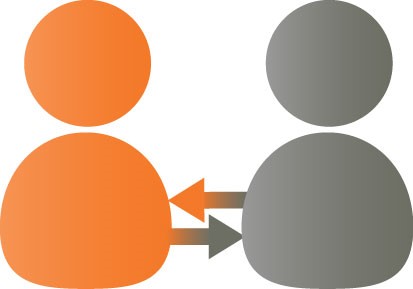Use Multiple Approaches
The most helpful parts of the training were that we all got to practice. The presenters were excellent. It was nice because it was such a small group. The training felt very personal. Everyone interacted and was able to ask any question. Each staff member’s role was discussed.
– Clinic administrator
Train in Phases
Consider rolling out training in phases. Given the amount of information to be shared and learned for a successful integration project, it can be useful to segment the training. For example, a preliminary phase could involve basic introductions of the project and its goals. This can be done at all-staff meetings.
Next, scheduled trainings provide staff with a basic understanding of the concepts around HIV and opt-out HIV testing, familiarize them with the process of asking every patient about HIV testing, and give them the basic “how to’s” involving EHR use and testing procedures.
Then, follow-up trainings can provide one-on-one “elbow” training to help users customize their EHR settings, plus group trainings with lab test vendors to practice testing procedures. In later stages, additional trainings can focus on more complicated interactions with patients.
Involve Staff at All Levels
All staff who see patients, from the front desk to the provider, will need some level of training on opt-out HIV testing. When it comes to knowledge about HIV, staff differ widely in their comfort with the topic, in their knowledge, and in their confidence about talking about HIV. Front desk staff and MA’s are most likely to lack such comfort, knowledge and confidence. In fact, you may be introducing information that’s totally new to them. Providers, on the other hand, are likely to come with significantly advanced knowledge and comfort. On the other hand, all staff will need to learn the new workflow and those using the EHR will need to learn new procedures.
Initial trainings may be done in an all-staff setting or with specific types of staff. Regardless, here are a few things to keep in mind:
 |
Know your audience: ask harder questions on a knowledge, attitudes and beliefs quiz if the room is full of clinicians than if it’s full of MA’s. |
 |
Peer trainers can be helpful. Including them can share the workload and it can encourage buy-in from staff. |
 |
If cheat sheets or other references don’t exist, maybe staff can help develop them for you. This helps people learn, and the increased ownership results in more accountability and engagement. |
 |
You can’t expect to conduct in-person trainings every time a new staff member joins the team. Make a few training videos, broken into 2-3 minute segments, and require their viewing by all new staff. Our videos include a general overview of HIV and labs, instructions for using templates in the EHR, and an overview of various patient dialogs associated with opt-out screening. All new staff are expected to watch these during the onboarding process, and existing staff watch select videos annually to ensure they’re current on the project. |
Make Trainings Interactive
The more interactive a training is, the more engaged staff will feel, and the more new information they’ll retain. Successful trainings can even build a sense of community among staff. You can make trainings more interactive in many ways, among them:
- Don’t rely on PowerPoint or other tools that create a “lecture” atmosphere.
- Seat attendees in a circle so they can engage with each other.
- Encourage discussion and have people share stories relating to HIV, including their experiences dealing with patients who have received positive results.
- Change the group dynamic by having someone other than team management deliver the trainings.
- Help create a positive environment and encourage more interaction, by offering incentives to attendees who may be concerned about being pulled away from their ongoing responsibilities. Launch a round of training by sharing promotional materials (pens, pads, backpacks, i.e. “swag”). Offer small giftcards to staff who respond to questions or volunteer for a training activity.
- Employ a variety of learning methods; the variety will cover more individuals’ learning styles and keep everyone’s attention.
Address Organizational Culture
Every organization faces different challenges, and attitudes toward training vary. Lack of time and lack of resources can make it hard to complete staff trainings when every minute away from seeing patients represents a loss of revenue. Our grant funding to implement opt-out HIV testing provided the resources, yet it was often difficult to get on staff training calendars at the frequency we wanted. In addition to all the strategies outlined under Lay the Groundwork, persistence, a non-judgmental attitude, and incentives can go a long way to overcoming organizational barriers.
Address Patient Culture
Each patient population has its own cultural identity, and it’s important to be sensitive to cultural differences. HIV needs to be discussed with patients in a culturally sensitive manner. For example, with a heavily Hispanic population, it was important for us to train staff to expect to deal with the stigma of HIV and to help patients understand that HIV testing is now routine and asked of everyone. It’s also crucial to set aside time in each clinic training to specifically practice dialog in all relevant languages.
Address Staff Questions and Follow Up Post-Training
It’s important to address all questions staff have. Questions may occur during a training, or they may come up afterward as staff try to implement what they learned. Such post-training support is key to maintaining any enthusiasm generated at the training. Approaches to providing such support include:
 |
Include subject matter experts at trainings so questions can be addressed as they occur. For example, we often had one of the experts from our HIV Team available to provide on the spot feedback. |
 |
Identify HIV testing champions at each site. It’s ideal to identify a champion from each job class within the site, so that others have a peer they can seek out for help. These champions can even receive extra training that helps them feel empowered to respond to staff questions. |
 |
Find ways to check in with staff, both MA’s and clinicians, after training. Feedback can be obtained at regular check-ins during scheduled staff meetings or in-person by the site-level project champion. |
Resources
- HIV Training Video- HR Onboarding: Overview of the testing program shared with new staff. Discusses reasons for testing and need for non-judgmental care (.mov)
- Train the Trainer Road Map: Flier introducing the Train the Trainers program (.doc or .pdf)
- Train the Trainer Intro Slides: PowerPoint slides used to introduce training concepts to new trainers in our Train the Trainers program (.doc or .pdf)
- Train the Trainer Adult Learning Principles Slides: PowerPoint slides used to teach adult learning principles and learning methods to new trainers in our Train the Trainers program (.doc or .pdf)
- Train the Trainer Post-Training Survey: Contents of a SurveyMonkey survey used to assess the training we provided to new trainers in our Train the Trainers program (.doc or .pdf)
![$logo['alt']](https://srhealth.org/wp-content/uploads/2017/03/srch-logo-1.png)